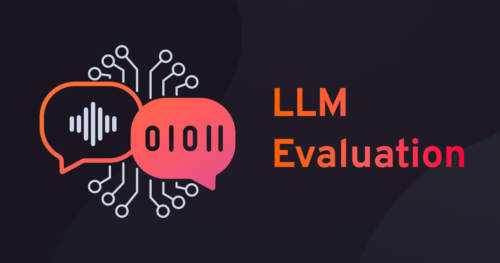Introduction to LLM Evaluation
Large language models (LLMs) are the backbone of AI systems with NLP capabilities. As LLMs run many AI applications and technologies, such as AI copilots, AI Agnets, and speech recognition technologies, evaluation of LLM performance, accuracy, and efficiency is key. In this article, we will provide technical details on how LLMs are evaluated.
A thorough evaluation of language model capabilities is crucial to measure their effectiveness and ensure these advanced systems meet the high bar for their many LLM use cases. To do this precise LLM evaluation metrics are needed.
What is LLM Evaluation?
LLM evaluation is a complex process to assess the capabilities and functionalities of large language models. The evaluation framework helps identify strengths and weaknesses, guiding developers in refining models and selecting the best fit for specific project requirements. Let’s start with a brief but comprehensive overview of LLM accuracy.
Importance of LLM Accuracy
In the current landscape, large language models are being applied to many sectors. This includes the integration of large language models in healthcare, a pivotal development that is reshaping the industry. Also, LLMs are being employed in banking and AI customer service to enhance efficiency and effectiveness. So it’s important to regularly evaluate these models to ensure their accuracy and reliability to produce valid responses, avoid AI mistakes, and reduce AI hallucinations.
The core of LLM performance evaluation is to understand the effectiveness of the foundation models. This is done by testing against evaluation datasets, which are designed to push the limits of an LLM or model’s performance, accuracy, fluency, and relevance. This deep analysis shows how the model processes and generates language for applications from question answering to content creation.
Moving to system evaluation, we look at specific components within the LLM framework such as prompts and contexts which are crucial for real world application of these models. Tools like OpenAI’s Eval library and open source libraries such as Hugging Face’s platforms provide valuable resources to evaluate the foundation models. These tools not only enable comparison but also give developers the empirical evidence to fine-tune LLMs for their use cases.
How to evaluate LLMs is as much about refining the algorithms underneath as it is about the final integration in a specific context to be seamless and productive. Choosing the right model is key as it’s the foundation upon which businesses and developers can build innovative and reliable solutions that meet user requirements in this ever-changing tech landscape.

LLM Evaluation Framework
LLM Evaluation Framework
As we get deeper into artificial intelligence, Agentic AI systems and large language models are having more and more impact across industries. After LLM security concerns have been addressed, the focus shifts to ensuring these models perform reliably across various tasks and domains. To understand why evaluating LLMs is so important we need to think about the breadth of applications for LLMs and how that is outpacing traditional feedback mechanisms to monitor their performance. The LLM evaluation process is necessary for several reasons.
Firstly, it provides a window into the model’s reliability and speed – the two key factors that determine how an AI will perform in the real world. Without a robust and current evaluation method,s you will have inaccuracies and inefficiencies going unchecked which will lead to poor user experience. Evaluating LLMs gives businesses and practitioners the insights to tune these models so they are properly calibrated to serve the AI and the specific needs of their deployments.
CLASSic Framework
Aisera, a leader in Agentic AI for Fortune 500 companies, introduces the CLASSic Framework, a framework to benchmark enterprise AI agents across 5 areas. Cost is the operational expense of the agent, including API usage, tokens, and infrastructure. Latency is the end to end response time, how fast the task gets executed. Accuracy is the precision of workflow selection and execution. Stability is the robustness of the model across different inputs, domains and operational conditions. Security is the resistance to adversarial inputs, prompt injection and data leaks. This framework provides a data driven way to optimize AI agent performance in real world enterprise use cases.
What LLM Evaluation Metrics Are?
Recognizing the diversity of applications that modern large language models serve, it becomes evident that a one-size-fits-all approach to LLM performance evaluation is impractical. Rather, the large language model evaluation process must adapt to the intricacies of various use cases, employing tailored LLM evaluation metrics that accurately reflect the unique demands of each scenario.
Context-Specific Evaluation
When deploying LLMs in education, for instance, developers meticulously examine the age-appropriateness of the model’s responses, as well as their propensity to avoid toxic outputs. Similarly, consumer-facing applications may prioritize response relevance and the capacity of a model to sustain coherent and engaging interactions. All these evaluation points are influenced significantly by the selection and structuring of the LLM prompts and contexts.
- Relevance: Does the LLM provide information pertinent to the user’s query?
- Hallucination: Is the model prone to generating factually incorrect or illogical statements? Is the model prone to generating factually incorrect or illogical statements? What improvements can be made to reduce AI hallucinations?
- Question-answering accuracy: How effectively can the LLM handle direct user inquiries?
- Toxicity: Are the model outputs clear of offensive or harmful content?
- Bleu score: The BLEU (Bilingual Evaluation Understudy) score measures the similarity between a machine-generated text and a reference human translation. It evaluates how closely the machine output matches the human reference, often used in translation tasks.
- Rouge score: The ROUGE (Recall-Oriented Understudy for Gisting Evaluation) score is a set of metrics for evaluating automatic summarization and machine translations. It focuses on recall, assessing how much of the reference content is captured in the generated summary or translation.
Advanced Evaluation Techniques
Encapsulated in tools like the Phoenix evaluation framework, these considerations form the bedrock of a robust evaluation system, emphasizing the significance of contextual relevance in the dynamic between question and reference texts.
| LLM Evaluation Metric | Relevance to Use Case | Tools for Measurement |
| Age Appropriateness | Essential for educational content aimed at children | Content filtering algorithms, manual expert reviews |
| Response Relevance | Crucial for customer service bots and information retrieval systems | Relevance scoring based on user interaction data |
| Accuracy in Question-Answering | Key in research, analytical tasks, and educational applications | Automated QA testing, human evaluation, community feedback |
| Minimization of Toxicity | Vital for all public-facing applications | Toxicity detection software, sentiment analysis tools |
User Experience Metrics
Beyond these primary metrics, evaluating the overall user experience is crucial. This involves assessing how intuitive and user-friendly the LLM is, which includes:
- Response Time: How quickly does the LLM generate responses?
- User Satisfaction: Are users satisfied with the interactions? This can be measured through feedback and engagement metrics.
- Error Recovery: How well does the LLM handle errors or misunderstandings? Effective error recovery mechanisms enhance user trust and reliability.
Guided by specific use cases, LLM system evaluation transcends mere number-crunching. It is an exercise in understanding the nuanced requirements of various applications, thereby shaping a more inclusive and responsible approach to AI development and implementation.

Model Evaluation Templates
You can choose a variety of prompt templates for evaluating your fine-tuned large language model using the LLM Eval module.
1- General
The General template provides a standardized framework for evaluating language models and comparing fine-tuned model responses to reference scores. It utilizes common NLP metrics to assess the overall performance and accuracy of the generated outputs.
2- TruthfulQA
The TruthfulQA template assesses a model’s performance based on the TruthfulQA benchmark, which evaluates how models avoid generating false responses. It ensures models generate truthful answers, avoiding human-like falsehoods, and uses zero-shot generative tasks to measure response quality.
3- LLM-as-a-Judge
The LLM-as-a-Judge template uses a strong LLM to evaluate the outputs of another LLM, leveraging AI to assess the quality of responses. The model acts as a judge, comparing predicted outputs against ideal responses, and scores them using methods like LangChain’s CriteriaEvalChain.
Applications of LLM Evaluation
The rigorous assessment of LLMs is more than an academic exercise; it is a business imperative in a data-driven world. Measuring the capabilities and limitations of LLMs with precise evaluation metrics enables us to harness their full potential, optimize their application in diverse fields, and ensure they serve our objectives effectively.
Performance Assessment
In assessing the performance of LLMs, a range of metrics is utilized to understand how effectively these models interpret human language and provide accurate responses. This covers tests to evaluate comprehension, information extraction, and the quality of generated text in response to varying input conditions.
Ground Truth Evaluation
Ground truth evaluation is a critical aspect of performance assessment, providing the reality against which LLM predictions are compared. It involves establishing labeled datasets that represent the true outcomes, allowing for objective evaluation of the model’s accuracy and effectiveness in capturing real-world language patterns.
Through ground truth evaluation, the strengths and limitations of LLMs can be identified, enabling improvements in their performance and application across diverse domains.
Model Comparison
When businesses and researchers are faced with selecting an LLM, they look for comprehensive data to compare performance. By implementing LLM performance evaluation techniques, they obtain comparative insights into fluency, coherence, and the ability of models to handle domain-specific content.
Bias Detection and Mitigation
Bias detection is an essential element of the current model evaluation techniques, identifying situations where the model might produce prejudiced outcomes. Effective LLM or AI agent evaluation aids in strategizing improvements, ensuring outputs from LLMs are fair and ethical.
Comparative Analysis
In LLM performance evaluation, alongside tracking model evolution, hands-on user feedback, and satisfaction metrics, the integration and impact of LLM embeddings also need to be considered. By examining the strengths and weaknesses of LLMs, a comparative analysis helps chart a course for enhanced user trust and better-aligned AI solutions.
| Performance Indicator | Metric | Application in LLM Evaluation |
| Accuracy | Task Success Rate | Measuring the model’s ability to produce correct responses to prompts |
| Fluency | Perplexity | Assessing the natural flow and readability of text generated by the LLM |
| Relevance | ROUGE Scores | Evaluating content relevance and alignment with user input |
| Bias | Disparity Analysis | Identifying and mitigating biases within model responses |
| Coherence | Coh-Metrix | Analyzing logical consistency and clarity over longer stretches of text |
The pursuit of excellence in artificial intelligence through comprehensive LLM performance evaluation methods not only propels the field forward but also ensures that the AI systems we build reflect our values and serve our needs efficiently.

Model Evaluations vs System Evaluations
Understanding the nuances between LLM evaluations and LLM system evaluations is critical for stakeholders looking to harness the full potential of large language models. LLM model evaluations are designed to gauge the raw capability of the models, focusing on their ability to understand, generate, and manipulate language within the appropriate context.
In contrast, system evaluations are tailored to observe how these models perform within a predetermined framework, examining functionalities that are within the user’s influence.
Evaluating LLMs encompasses a broad spectrum of tasks and diverse predefined evaluation metrics to ensure objectivity and precision. For those pondering how to evaluate models and LLMs effectively, appreciating the differences and applications of these two types of evaluations is fundamental. Here we break down and compare the essential metrics used in model vs. system evaluations:
| Evaluation Criteria | Model Evaluation | System Evaluation |
| Primary Focus | Overall performance and intelligence of the LLM on multiple tasks | Specific use-case effectiveness and integration within a system |
| Metrics Used | Multitasking measures such as MMLU, complexity, and coherence | Precision, recall, and system-specific success rates |
| End Goal | Broad evaluation across a range of scenarios | Optimization of prompts and user experience |
| Impact on Development | Informs foundational development and enhancements | Directly affects user interaction and satisfaction |
For developers and machine learning practitioners, the distinction between these evaluations is much more than academic; it directly influences their work and strategic approach toward improving LLM evaluation methods.
Foundational model builders consistently push the frontiers of what their LLM can do, testing it against divergent cases and refining its core functionalities. Meanwhile, system evaluators prioritize how to evaluate LLM effectiveness within specific contexts, often necessitating frequent iterations to enhance the user experience and overall system reliability.
- Model evaluators question, “How comprehensive and adaptable is the LLM?”
- System evaluators ask, “How well does this LLM perform for the specific tasks at hand?”
Taking these differences into account enables targeted strategies for advancing LLMs. Therefore, evaluating large language models through both lenses ensures a comprehensive understanding of their capacities and limitations, thereby supporting the development of more efficient, ethical, and usable AI systems.
5 Benchmarking Steps for a Better Evaluation
To determine benchmark performance and measure LLM evaluation edge cases comprehensively, a structured approach is vital. These five steps can streamline the process and enhance the accuracy of your evaluations.
- Curate benchmark tasks: Design a set of language tasks that cover a spectrum from simple to complex, ensuring the benchmark captures the breadth of LLM capabilities.
- Prepare datasets: Use diverse, representative datasets that have been carefully curated to avoid biases and evaluate the LLM’s performance on a level playing field.
- Implement fine-tuning: LLM fine-tuning techniques and LLM gateway using the prepared datasets to bolster the LLM’s ability to handle language tasks effectively.
- Evaluate with metrics: Utilize established evaluation metrics such as perplexity, ROUGE, and diversity to assess the performance of the LLM objectively.
- Analyze results: Interpret the data gathered to compare and contrast the performance of different LLMs, offering insights that could guide future improvements.
Upon completing these steps, you’ll have a thorough understanding of how LLMs perform under a variety of scenarios, which is essential for LLM applications and further development. Below is a detailed table summarizing the key performance metrics used in LLM evaluation.
| Metric | Description | Application |
| Perplexity | Measures uncertainty in predicting the next token. | General language proficiency |
| ROUGE | Compares an LLM’s output with a set of reference summaries. | Summarization tasks |
| Diversity | Evaluates the variety of responses generated. | Creativity and variation in output |
| Human Evaluation | Subjective assessment by human judges. | Relevance and coherence |
LLM Evaluation Best Practices
In the realm of large language model evaluation, precision in methodology is paramount. Enhancing the integrity and effectiveness of evaluations requires adherence to established best practices. Armed with LLM strategy, developers and researchers can proficiently navigate the complexities of LLM evaluation and progression.
Leveraging LLMOps
Central to refining LLM evaluation processes is the strategic utilization of LLMOps. This practice involves the orchestration and automation of LLM workflows to avoid data contamination and biases.
Collaborative tools and operational frameworks, often offered by esteemed institutions, are pivotal in achieving consistent and transparent results. These systems allow practitioners to rigorously assess and deploy language models while facilitating accountability for the data sources they incorporate.
Multiple LLM evaluation metrics
In the pursuit of LLM evaluation best practices, deploying a diversity of metrics is non-negotiable. It is critical that evaluations are not monolithic but rather encompass a broad spectrum assessing fluency, coherence, relevance, and context understanding.
Evaluating large language models with multifaceted metrics not only reflects the nuanced capabilities of these systems but also ensures their applicability across various communication domains. Such rigorous scrutiny bolsters the reliability and versatility of the models in question.
Real-world evaluation
Beyond lab-controlled conditions lies the realm of real-world applications — a space where theory meets pragmatism. Validating LLMs through practical usage scenarios confirms their effectiveness, user satisfaction, and adaptability to unexpected variables.
This practice takes large language model evaluation out of the abstract and deposits it firmly in the tangible, user-centric world where the true test of utility takes place. Furthermore, integrating known training data into evaluations ensures that the datasets mirror a wide range of acceptable responses, making the evaluation as encompassing and comprehensive as possible.
Conclusion
In conclusion, the comprehensive standardized evaluation framework of Large Language Models (LLMs) is a cornerstone in the advancement of AI technologies. It ensures that these powerful tools are not only effective but also align with ethical standards and practical needs.
As LLMs continue to evolve, Enterprise LLM emerges as a pivotal aspect, offering tailored, accessible AI solutions across industries. This approach underscores the importance of meticulous LLM evaluation methods in delivering reliable, bias-free, and efficient AI services.
Monitoring the performance and accuracy of LLMs is essential. But to achieve high-performing large language models that meet all evaluation metrics, it is recommended to use retrieval augmented generation (RAG) or fine-tuning methods on domain-specific LLMs.
You can see the AI agents benchmark report as an excellent step if you are eager to witness the transformative impact of domain-specific AI Agents firsthand. It provides an opportunity to experience the capabilities of LLMs in real-world applications and understand their potential to drive innovation and efficiency.

